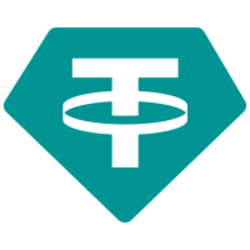
USDTTether
Mkt Cap
$183.38B24H Volume
$83.9BFDV
$183.38BCirc Supply
183.45BTotal Supply
183.45BUSDT Fundamentals
Max Supply
0.007D High
$1.007D Low
$0.999624H High
$1.0024H Low
$0.9993All-Time High
$1.32All-Time Low
$0.5725USDT Prices
USDT / USD
$0.9996USDT / EUR
€0.8622USDT / GBP
£0.7599USDT / CAD
CA$1.40USDT / AUD
A$1.53USDT / INR
₹88.73USDT / NGN
NGN 1,443.86USDT / NZD
NZ$1.75USDT / PHP
₱58.67USDT / SGD
SGD 1.30USDT / ZAR
ZAR 17.36Tether’s Profits Surge Amid Stablecoin Growth and BlackRock’s Market Expansion
Stablecoin profitability drives the crypto economy, with issuers like Tether and Circle capturing 60% to 75% of daily protocol revenues by investing reserves in yield-bearing assets such as U.S. Treasuries,
coinotag·3h ago


Stablecoin issuers capture 75% of total crypto revenue
Stablecoin projects remain the top earners in the crypto economy, capturing roughly 60% to 75% of total daily protocol revenues across major categories. Tether’s CEO, Paolo Ardoino, even stated that the firm is on track for $15 billion in profit this year and an extraordinary 99% margin—making it one of the most profitable businesses globally on a per-employee basis. Tether and Circle invest user deposits in safe, yield-bearing assets Stablecoins have emerged as a major source of cryptocurrency liquidity and are utilized in exchanges, decentralized finance systems, and cross-border payment systems. Since they offer more stability compared to other tokens, such as Bitcoin and Ethereum, among others, which experience rapid value fluctuations, they have been instrumental for businesses and institutional investors in value transfer. Stablecoin issuers make money by earning interest on the assets backing their tokens. Companies like Tether and Circle are investing user deposits in safe, yield-bearing assets—mainly U.S. Treasuries and cash—and keep the returns rather than sharing them with users. The GENIUS Act, enacted in July, codifies this principle by preventing authorized stablecoin issuers from distributing any form of yield to holders. Lawmakers intended to position payment stablecoins as cash-like instruments, rather than investments. Nonetheless, growing stablecoin competition has forced some projects to experiment with distinct forms of initially spreading value. USDe is one of the major disruptors to emerge, creating a synthetic dollar model that instantly yields returns to holders. Users keeping USDC on Coinbase can also generate a 3.85% APY, though it was a creative check to the GENIUS Act’s issuer-provided yield prohibition. This represents a shift in how ROI is generated and distributed within the crypto community. BlackRock is increasingly involved in the stablecoin market In a report released in late September, Citi analysts predicted that stablecoin issuance could reach $4 trillion by the end of the decade, compared to approximately $280 billion today. Financial giant BlackRock has been increasing its involvement in the stablecoin market as demand for tokenized cash products grows. The company has long worked with Circle, the second-largest stablecoin issuer, overseeing most of its reserve fund. Following Circle’s high-profile stock market debut in June, the company is also exploring the option of offering similar services for reserve management to other stablecoin issuers. It has also been building on that, with its BSTBL fund serving as an important part of its broader strategy to expand in digital finance. Jon Steel, the global head of product and platform for BlackRock’s cash management business, told CNBC the fund helps the firm extend its reach in a rapidly maturing sector. He noted, “It represents an opportunity not just to help our clients if they’re looking to issue a stablecoin and how we can help them in doing that, but clearly this is going to create the potential for new distribution opportunities.” The fund is open to institutional investors, including pension funds and university endowments. Longer trading hours could benefit BlackRock’s clients in the Western United States by enabling them to manage daily cash flow and profit and loss (P&L) operations for a greater portion of the business day. The firm’s digital asset line already includes Bitcoin and Ethereum products, which were launched. Want your project in front of crypto’s top minds? Feature it in our next industry report, where data meets impact.
cryptopolitan·3h ago

Global regulators are reviewing new rules on banks’ crypto holdings after the rise of stablecoins
Global regulators are discussing possible adjustments to the rules on banks’ cryptocurrency holdings. This talk follows the increased adoption of stablecoins, triggering a US-driven response against the current regulations. The new changes are set to take effect next year. Regarding the initial regulations, sources pointed out that the Basel Committee on Banking Supervision established these standards in late 2022. According to the perspective of senior finance officials, banks viewed these rules as barriers to crypto exposure because they require considerable capital for such assets. Since then, the outlook on cryptocurrency has undergone a drastic change. In the present day, what US regulators once viewed as the “Wild West” of finance has evolved into an industry that has garnered significant support from the White House. Crypto community sparks concerns about the current crypto rules The shift in perspective towards cryptocurrency has sparked debates at the Basel Committee, raising questions about whether current regulations remain suitable for the digital asset. On the other hand, reports from reliable sources have highlighted that leading global jurisdictions, such as the US, UK, and EU, have not yet decided to implement these rules on schedule. According to sources close to the situation, US officials have argued that they have been at the forefront of calls for changes because they believe these standards do not align with the evolving needs of the industry, particularly regarding stablecoins. The officials’ statement marks a significant milestone in the crypto industry, as stablecoins are now regulated in the US following the approval of the GENIUS Act . This move has led to increased adoption of cryptocurrency as a means of payment globally. Still, the Basel standards impose high capital charges on permissionless stablecoins, such as Tether’s USDT and Circle’s USDC. Those tokens operate on public blockchain networks that are open to everyone, similar to how assets like Bitcoin work on the principles. According to these standards, if one holds permissionless crypto assets, they will face a risk charge of about 1,250% of the exposure. Analysts commented that this rate exceeded those imposed on other risky investments. For instance, certain venture capital investments in the latest Basel capital package incur a 400% charge. After careful consideration, some nations supported the officials’ viewpoint and emphasized that they intend to reassess these standards before they are widely adopted. In the meantime, executives at the European Central Bank (ECB) have shared their intention to implement the current regulations first and then consider making adjustments later. When reporters asked representatives from the Basel Committee, the Federal Reserve, and the ECB to comment, they declined to respond. Banks push for regulatory consistency in crypto rules The EU has established a crypto framework through a recent bank capital package. This framework enables stablecoins to benefit from the same capital treatments as the assets that back them. To maintain their value stability, stablecoins typically rely on reserves comprising cash and short-term US government bonds. Meanwhile, the Bank of England aims to implement its newly established rules on stablecoins later this month. The bank also indicated that its team is still developing guidelines for managing crypto assets and is consulting with other jurisdictions to ensure uniformity in these regulations. Singapore, on the other hand, announced that it would delay its timeline by a year to meet the global standards earlier this month. Hong Kong has also revealed its plans to release new rules in 2026, but has recently suggested loosening the requirements for licensed stablecoins. Get $50 free to trade crypto when you sign up to Bybit now
cryptopolitan·17h ago

Tether’s profit in Q1-Q3 surpassed $10 billion: report
Tether netted a record-breaking $10 billion plus profit in the first nine months of 2025, according to the latest attestation detailing the stablecoin issuer’s financial performance. USDT issuer shared details of its financial results for the first three quarters of the year on October 31. The flagship USDT stablecoin and substantial growth in its reserve assets stand out. Tether smashes past $10 billion in Q1-Q3 profit An attestation report, independently verified by global accounting firm BDO, shows that Tether International saw its net profit for the period from January to September 2025 surpass the $10 billion threshold. It means Tether has solidified its position as one of the most profitable privately held companies in the world. Part of the robust financial health came in Q3, despite ongoing global economic volatility capping anticipated upside momentum in October. Profits have come even as the company expands its investment and sees its global user base surpass 500 million. Artificial intelligence, energy, and peer-to-peer communication are top milestone endeavors for the company, Tether wrote in a blog post. USDT issuance explodes in Q3 A key highlight of the third quarter was the issuance of more than $17 billion in new USDT tokens, pushing the total circulating supply beyond $174 billion. Exposure to US Treasuries, both direct and indirect, hit $135 billion. Tether ranks as the 17th largest holder of US government debt globally, overtaking nations like South Korea. Additionally, the company’s holdings in gold and bitcoin totaled $12.9 billion and $9.9 billion, respectively. There’s over $6.8 billion in reserves, and BTC and gold account for approximately 13% of that. “Q3 2025 results reflect the continued trust and strength behind Tether, even amid a global challenging macroeconomic environment, reinforcing Tether’s brand as the ‘Stable Company’,” said Paolo Ardoino, CEO of Tether. As noted, Tether’s reserves stood at $181.2 billion as of September 30, 2025, exceeding its liabilities of $174.4 billion. The $6.8 billion excess reserve is a buffer that provides a strong safeguard for token holders. Ardoino added: “Investors and users alike continue to turn to USDT as the most reliable and liquid digital dollar, proving the enduring confidence in Tether’s model… Our consistent growth and discipline show that Tether is not only meeting global demand but also helping reinforce confidence in the broader digital economy.” Other investments Notably, Tether manages proprietary investments in sectors such as AI, energy, and infrastructure through affiliates, including Tether Holdings and Tether Investments. This means the company separates these pursuits from the reserves that back its USDT and other tokens. Tether saw its tokenized gold token, Tether Gold (XAUT), spike to new highs amid a surge in real-world asset tokenization. Gold’s march to a record-breaking peak in October also helped XAUT, with the token’s market cap surpassing 1.44 billion to hit the 2.1 billion mark. The post Tether’s profit in Q1-Q3 surpassed $10 billion: report appeared first on Invezz
invezz·18h ago

Tether Profits Topped $10B in First Nine Months of Year; Starts Share Buyback Program
The stablecoin issuer saw strong growth in the third quarter, reporting a $17 billion increase in circulating USDT and $135 billion exposure to U.S. Treasuries.
coindesk·20h ago

Venezuela’s Conexus to integrate Bitcoin and stablecoins in banking system
Conexus, Venezuela’s leading payments processor, plans to integrate Bitcoin and stablecoins like Tether (USDT), into the country’s banking network. The payments giant, which handles roughly 40% of electronic transfers in Venezuela, is eyeing a blockchain-based interbank network. Per a local report, the aim is to bring Bitcoin and stablecoin custody services to the banks’ customers. Conexus also sees the initiative as one that will bolster interbank transactions, with banks able to tap into fast and low cost cryptocurrency transfers. Customers will benefit from a system that helps mitigate hyperinflation and other currency woes. Rodolfo Gasparri, president of Conexus, shared the firm’s idea during an interview with local news outlet Banca y Negocios. “We are reaching a model of integration of payment methods,” he told the banking and technology news portal. According to Gasparri, crypto and blockchain have evolved into an essential part of the global financial system, and integrating these across the banking infrastructure is “a natural and inevitable” step. More Venezuelans using Bitcoin, stablecoins Conexus has taken note of the explosion in the number of Venezuelans using cryptocurrencies and stablecoins. Gasparri said more and more people see digital assets and stablecoins as a tool to hedge against hyperinflation. Tapping into blockchain technology to bring crypto deposits to bank customers is a major part of supporting this ecosystem, he added. But there’s more to blockchain. “This provides a lot of security, because it regulates the circulation of bitcoins and USDT with transparency and appropriate regulations. The holder of these monetary assets is truly protected,” he added. The impact of integrating Bitcoin and stablecoins in banking networks could be similar to how interbank mobile payments revolutionised the banking system, the Conexus president explained. Conexus’ move aligns with broader milestones across the global financial industry. Multiple banking giants and financial providers are allowing clients to buy crypto, trade, and custody BTC and other digital assets. These banks include those in the US, such as JPMorgan, Morgan Stanley, and Bank of America. SWIFT has also disclosed plans for a blockchain system, with migration of transactions on-chain targeting stablecoins such as USDT and other cryptocurrencies. Regulators eye global stablecoin rules review Bloomberg reported on October 31, 2025, that the explosion in demand and use of stablecoins has global regulators reexamining related banking rules. According to the publication, regulators are looking at banking rules pertaining to crypto holdings that are due to go into effect in 2026. The regulation, as crafted in 2022, imposes heavy capital requirements on banks, a stance that has so far seen many lenders avoid crypto integration. A review of the rules will update them to better align with the rapid stablecoin adoption. In 2025, the United States has been at the forefront of pushing for support for the sector with the GENIUS Act enacted into law this year , highlighting that push. The post Venezuela’s Conexus to integrate Bitcoin and stablecoins in banking system appeared first on Invezz
invezz·22h ago

T3 Financial Crime Unit, Backed by Tron, Tether, TRM Labs, Has Now Frozen $300M in Assets
The crypto industry’s most aggressive anti-crime task force just crossed another milestone.
coindesk·1d ago

Beijing Sentences Five in USDT Forex Case
Beijing court jailed five for USDT in illegal forex transfers.
coinpaprika·3d ago

Belarus Dealership Introduces Crypto Payments for Geely Cars, Including Bitcoin
Customers in Belarus can now purchase Geely and Belgee vehicles using cryptocurrencies like Bitcoin, Ethereum, and Tether through a partnership with licensed platform WhiteBird. This service offers the same pricing
coinotag·3d ago

Belarusians can now buy Geely cars with Bitcoin at local dealership
Cars produced by the Chinese automaker Geely and its local subsidiary in Belarus can now be purchased using cryptocurrencies. Customers will be getting the same prices and promotions, with the added benefit of using digital coins to make the payment through instant conversion to Belarusian fiat. Cryptocurrencies accepted for Geely and Belgee cars in Belarus A car dealership in Minsk, the capital city of Belarus, has launched a new service allowing buyers to spend cryptocurrency on their new vehicle. Tochka, the auto retailer, is offering the alternative payment option in collaboration with WhiteBird, one of the oldest licensed crypto platforms in the country. Belarusian media describes the initiative as the first case of integrating crypto payments in the Eastern European nation’s automotive market. Buyers can choose any of the models offered by Geely , as well as Belgee, a joint venture controlled by the Chinese automotive conglomerate and the Belarusian state-owned BelAZ. The latter is one of the world’s biggest manufacturers of large dump trucks and other heavy transport equipment for the mining and construction industries. Speaking to the Belarusian news outlet Office Life, a Tochka representative emphasized: “This is not an experiment or a promotion, but a full-fledged service operating within the legal framework of Belarus.” The spokesperson also noted Tochka embarked on the project to “meet the wishes of the modern generation of car drivers.” Crypto payments made possible through conversion to fiat Buyers can place crypto orders without even visiting the dealer’s office, as payments are processed online. They only need to contact Tochka and confirm the final price in Belarusian rubles. Customers are then transferred to a WhiteBird employee who helps them with exchanging their crypto into fiat at a preferential rate set specifically for the project. Once the transaction is finalized, the vehicle can be picked up at the showroom or delivered to any address in the territory of Belarus. Prices for crypto owners are the same as those for clients paying with rubles. They will also enjoy the same discounts for Geely or Belgee cars. The dealership expects to sell up to 10% of the cars it offers from the two brands for cryptocurrency under the newly implemented scheme. Belarus reacts to growing popularity of cryptocurrency Crypto payments have been gaining traction in Belarus, a close economic and political ally of both China and Russia, especially under Western sanctions that have restricted the access of its citizens and companies to traditional financial channels. The trend was recently highlighted by Belarusian President Alexander Lukashenko, who noted that the volume of external payments through cryptocurrency exchanges reached a record $1.7 billion in the first seven months of the year. Belarus is a regional leader in terms of efforts to regulate digital assets. It legalized crypto business for residents of the Belarus Hi Tech Park ( HTP ) in 2018, with a presidential decree signed by Lukashenko in late 2017. This year, the country’s long-term leader urged government officials and regulatory bodies in Minsk to swiftly update the national framework in order to catch up with the industry. Speaking at a conference devoted to the development of the digital token economy in early September, he was quoted by the official BelTA news agency as stating: “The task of the state in these conditions is to determine understandable, transparent rules of the game and mechanisms for control in this sphere.” WhiteBird, car dealer Tochka’s partner for the crypto payments feature, is registered at the HTP hub and is arguably the first coin trading platform to obtain a Belarusian license. In September, the exchange also helped Wildberries, Russia’s largest online retailer, to offer its Belarusian customers the option to pay with major cryptocurrencies, as reported by Cryptopolitan. The Russian e-commerce giant now accepts Bitcoin (BTC), Ethereum (ETH), and the U.S. dollar-pegged stablecoin Tether (USDT), among others, through an integration with WhiteBird in Belarus. Want your project in front of crypto’s top minds? Feature it in our next industry report, where data meets impact.
cryptopolitan·3d ago
Sentiment
Indicates whether most users posting on a symbol’s stream over the last 24 hours are fearful or greedy.
0
25
50
75
100
Extreme
Fear
Neutral
Greed
Extreme
Fear
Greed
N/A
Last score
N/A
1 day ago
Sign Up / Log In
1 week ago
Sign Up / Log In
1 month ago
Sign Up / Log In
3 months ago
Sign Up / Log In
6 months ago
Sign Up / Log In
1 year ago
Sign Up / Log In
Message Volume
Measures the total amount of chatter on a stream over the last 24 hours.
0
25
50
75
100
Extremely
Low
Normal
High
Extremely
Low
High
N/A
Last score
N/A
1 day ago
Sign Up / Log In
1 week ago
Sign Up / Log In
1 month ago
Sign Up / Log In
3 months ago
Sign Up / Log In
6 months ago
Sign Up / Log In
1 year ago
Sign Up / Log In
Participation Ratio
Measures the number of unique accounts posting on a stream relative to the number of total messages on that stream.
0
25
50
75
100
Extremely
Low
Normal
High
Extremely
Low
High
N/A
Last score
N/A
1 day ago
Sign Up / Log In
1 week ago
Sign Up / Log In
1 month ago
Sign Up / Log In
3 months ago
Sign Up / Log In
6 months ago
Sign Up / Log In
1 year ago
Sign Up / Log In
AboutTether (USDT) is a cryptocurrency with a value meant to mirror the value of the U.S. dollar. The idea was to create a stable cryptocurrency that can be used like digital dollars. Coins that serve this purpose of being a stable dollar substitute are called “stable coins.” Tether is the most popular stable coin and even acts as a dollar replacement on many popular exchanges! According to their site, Tether converts cash into digital currency, to anchor or “tether” the value of the coin to the price of national currencies like the US dollar, the Euro, and the Yen. Like other cryptos it uses blockchain. Unlike other cryptos, it is [according to the official Tether site] “100% backed by USD” (USD is held in reserve). The primary use of Tether is that it offers some stability to the otherwise volatile crypto space and offers liquidity to exchanges who can’t deal in dollars and with banks (for example to the sometimes controversial but leading exchange Bitfinex). The digital coins are issued by a company called Tether Limited that is governed by the laws of the British Virgin Islands, according to the legal part of its website. It is incorporated in Hong Kong. It has emerged that Jan Ludovicus van der Velde is the CEO of cryptocurrency exchange Bitfinex, which has been accused of being involved in the price manipulation of bitcoin, as well as tether. Many people trading on exchanges, including Bitfinex, will use tether to buy other cryptocurrencies like bitcoin. Tether Limited argues that using this method to buy virtual currencies allows users to move fiat in and out of an exchange more quickly and cheaply. Also, exchanges typically have rocky relationships with banks, and using Tether is a way to circumvent that. USDT is fairly simple to use. Once on exchanges like Poloniex or Bittrex, it can be used to purchase Bitcoin and other cryptocurrencies. It can be easily transferred from an exchange to any Omni Layer enabled wallet. Tether has no transaction fees, although external wallets and exchanges may charge one. In order to convert USDT to USD and vise versa through the Tether.to Platform, users must pay a small fee. Buying and selling Tether for Bitcoin can be done through a variety of exchanges like the ones mentioned previously or through the Tether.to platform, which also allows the conversion between USD to and from your bank account.
DetailsLinks
Source
Categories
Aptos EcosystemAvalanche EcosystemCelo EcosystemEthereum EcosystemFTX HoldingsFiat-backed StablecoinKaia EcosystemKava EcosystemNear Protocol EcosystemSolana EcosystemStablecoinsTON EcosystemTron EcosystemUSD StablecoinWorld Liberty Financial Portfolio
Date
Market Cap
Volume
Close
November 01, 2025
$183.38B
$83.9B
---
November 01, 2025
$183.36B
$105.58B
---
October 31, 2025
$183.37B
$123.92B
$1.00
October 30, 2025
$183.39B
$110.66B
$1.00
October 29, 2025
$183.29B
$100.53B
$1.00
October 28, 2025
$183.2B
$113.41B
$1.00
October 27, 2025
$183.19B
$77.96B
$1.00
October 26, 2025
$182.96B
$46.16B
$1.00
October 25, 2025
$182.96B
$94.04B
$1.00
October 24, 2025
$182.58B
$103.53B
$1.00











